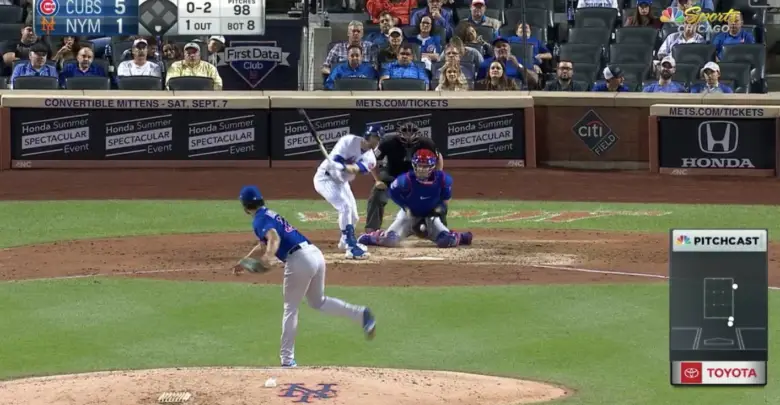
Curves Ahead: Darvish Knuckles Down, Hendricks Learning to Deviate from Plan
Pitchers are odd birds, creatures of habit whose lives are laid out in five-day cycles from which any deviation can be disastrous. Okay, there might be a little hyperbole in there, but it’s definitely true that routine is key for starting pitchers in particular. That’s why it’s so interesting that two members of the Cubs’ rotation are experiencing success by doing something different.
The first of those is Yu Darvish, who just decided to start throwing a knuckle curve. After learning it from Craig Kimbrel in the days leading up to his start against the Giants last week, Darvish tried it out in a bullpen session and felt confident enough to add it to his repertoire. Folks, that’s not normal. Some pitchers need months or even years to flesh out a new offering.
But not Darvish, who got two swinging strikeouts with the new breaking ball that has greater velocity and tighter spin than his typical bender. You can see the knuckle curve in action at about the :50 and 1:15 marks of the video below, the latter of which features Jeff McNeil flailing impotently at a pitch he had no idea was coming.
What you don’t see is the unreal sequence Darvish spun previously, starting with a 79 mph slider on the lower-outside corner that the lefty-hitting McNeil fouled off. Then Darvish lobbed in a nice 69 mph curve just below his first pitch for a swinging strike before going up and a way with a 94 mph fastball. With an 0-2 count and the confidence of the previous 7+ innings behind him, Darvish uncorked his new vintage.
Released more like his fastball, the breaking pitch nose-dived into the dirt as McNeil made like Discount King Arthur and pulled his sword with an awkward wave. Then the confused batter turned around as if to ask home plate umpire Chad Whitson whether such a pitch was even fair. McNeil may have been asking whether it was a dropped third strike, but he made no move toward first and was easily tagged for good measure.
Though Darvish’s streak of 142 consecutive batters faced with a walk came to an end in Queens, he may actually be better for it. Not only does he have the new weapon to keep hitters off-balance, but alleviating the pressure of trying to avoid walks may allow him to be more relaxed and less predictable moving forward.
That appeared to be the case Tuesday night, as Darvish allowed four hits — including a homer and triple — on a lot of hard contact through the first four innings. After walking Todd Frazier on four pitches to lead off the 5th, however, Darvish allowed just one more single and racked up four of his seven strikeouts.
From Cubs notes: Darvish ended August with 42 K, 1 BB. Elias: Darvish 4th pitcher since 1893, when the mound was set at its current distance, with at least 40 K and no more than 1 BB in a calendar month, joining Kluber (41/1, 5/2018), Samardzija (49/1, 5/2017), Lee (54/1, 9/2013)
— Mark Gonzales (@MDGonzales) August 28, 2019
That was only Darvish’s second walk issued since the 6th inning of his July 12 start against the Pirates, and he hasn’t walked two in a game since June 26 against the Braves. He hasn’t issued three free passes since June 5, a span of 14 starts, though he’s given up multiple homers six times in that same period. That’s where the new pitch and being less predictable with two strikes should help down the stretch.
The same is true for Kyle Hendricks, who has learned that sticking to the gameplan isn’t always the best course of action. As Tony Andracki writes for NBC Sports Chicago, the righty is trying to emulate Jon Lester by adjusting on the fly and being more willing to use his curve instead of his sinker as the game wears on.
“It’s not always going to go according to plan,” Hendricks said. “[The hitters] make adjustments just as quick as we do, if not quicker. Being able to realize that and just know what you need to do quicker, that’s what I try to learn from [Lester]. He does that better than anybody I’ve ever seen.”
Those adjustments should help Hendricks to balance his road performance with what he’s done at Wrigley so far his year. Much of the disparity can be attributed to two or three aberrant starts, but Hendricks does need to achieve more consistent results in order to push the Cubs through these final few weeks.
More than what they’re throwing and when they’re throwing it, the real key for both Darvish and Hendricks is confidence. Both of them have proven that they’re perfectly capable of ace-level performances, it’s simply a matter of knowing each time out that they can do it no matter what. For Darvish, that could mean being willing to miss once in while. For Hendricks, it’s trusting that secondary offering in big moments.
In other words, they need to take those curveballs the game throws at them and just throw them right back.

